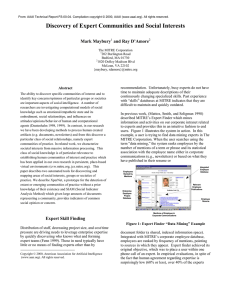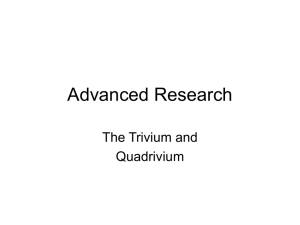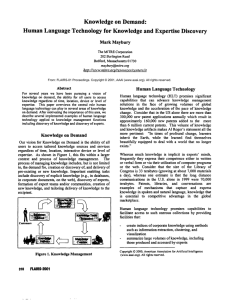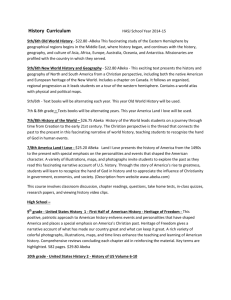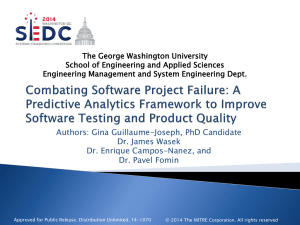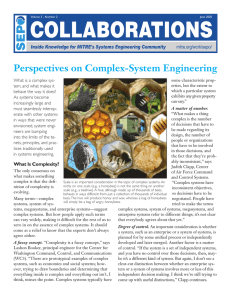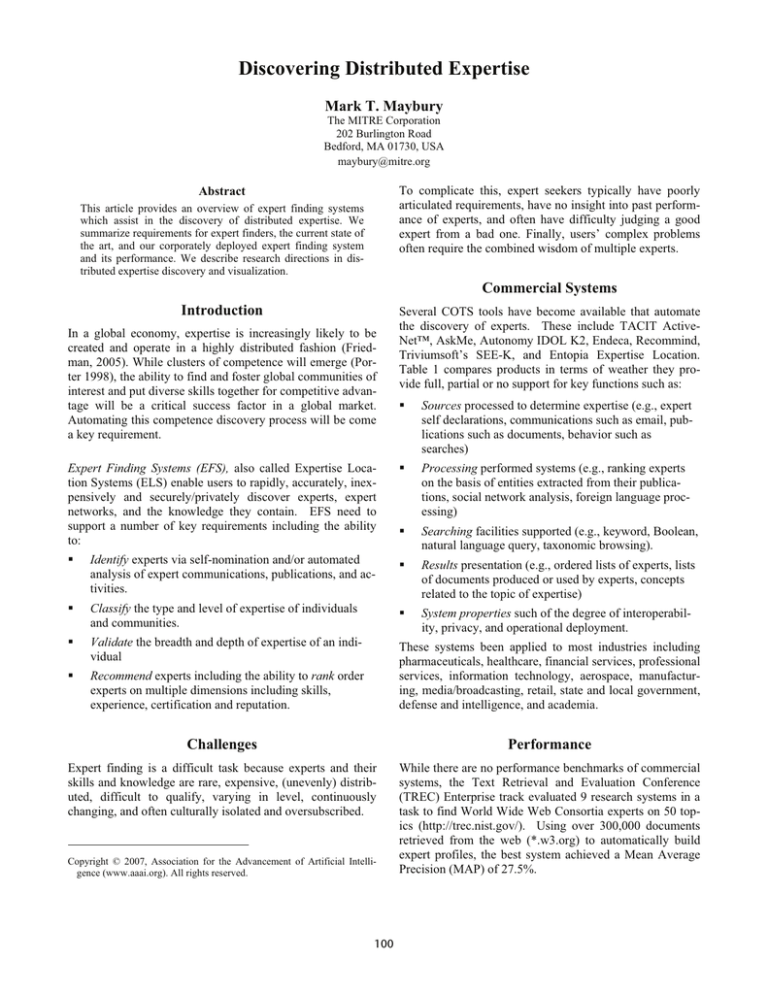
Discovering Distributed Expertise
Mark T. Maybury
The MITRE Corporation
202 Burlington Road
Bedford, MA 01730, USA
maybury@mitre.org
To complicate this, expert seekers typically have poorly
articulated requirements, have no insight into past performance of experts, and often have difficulty judging a good
expert from a bad one. Finally, users’ complex problems
often require the combined wisdom of multiple experts.
Abstract
This article provides an overview of expert finding systems
which assist in the discovery of distributed expertise. We
summarize requirements for expert finders, the current state of
the art, and our corporately deployed expert finding system
and its performance. We describe research directions in distributed expertise discovery and visualization.
Commercial Systems
Introduction
In a global economy, expertise is increasingly likely to be
created and operate in a highly distributed fashion (Friedman, 2005). While clusters of competence will emerge (Porter 1998), the ability to find and foster global communities of
interest and put diverse skills together for competitive advantage will be a critical success factor in a global market.
Automating this competence discovery process will be come
a key requirement.
Several COTS tools have become available that automate
the discovery of experts. These include TACIT ActiveNet™, AskMe, Autonomy IDOL K2, Endeca, Recommind,
Triviumsoft’s SEE-K, and Entopia Expertise Location.
Table 1 compares products in terms of weather they provide full, partial or no support for key functions such as:
Sources processed to determine expertise (e.g., expert
self declarations, communications such as email, publications such as documents, behavior such as
searches)
Expert Finding Systems (EFS), also called Expertise Location Systems (ELS) enable users to rapidly, accurately, inexpensively and securely/privately discover experts, expert
networks, and the knowledge they contain. EFS need to
support a number of key requirements including the ability
to:
Processing performed systems (e.g., ranking experts
on the basis of entities extracted from their publications, social network analysis, foreign language processing)
Searching facilities supported (e.g., keyword, Boolean,
natural language query, taxonomic browsing).
Identify experts via self-nomination and/or automated
analysis of expert communications, publications, and activities.
Results presentation (e.g., ordered lists of experts, lists
of documents produced or used by experts, concepts
related to the topic of expertise)
Classify the type and level of expertise of individuals
and communities.
System properties such of the degree of interoperability, privacy, and operational deployment.
Validate the breadth and depth of expertise of an individual
Recommend experts including the ability to rank order
experts on multiple dimensions including skills,
experience, certification and reputation.
These systems been applied to most industries including
pharmaceuticals, healthcare, financial services, professional
services, information technology, aerospace, manufacturing, media/broadcasting, retail, state and local government,
defense and intelligence, and academia.
Challenges
Performance
Expert finding is a difficult task because experts and their
skills and knowledge are rare, expensive, (unevenly) distributed, difficult to qualify, varying in level, continuously
changing, and often culturally isolated and oversubscribed.
While there are no performance benchmarks of commercial
systems, the Text Retrieval and Evaluation Conference
(TREC) Enterprise track evaluated 9 research systems in a
task to find World Wide Web Consortia experts on 50 topics (http://trec.nist.gov/). Using over 300,000 documents
retrieved from the web (*.w3.org) to automatically build
expert profiles, the best system achieved a Mean Average
Precision (MAP) of 27.5%.
Copyright © 2007, Association for the Advancement of Artificial Intelligence (www.aaai.org). All rights reserved.
100
Expert Finding Tools
Sources
Full
Partial
None
PRODUCT
Processing
Search
Results System
Self declaration
Email
Documents
Briefings
Resumes
Web pages
Databases
Behavior/searches
Ranking
Entity Extraction
Social Net Analysis
Foreign Language (#)
Author Identification
Keyword
Boolean
Natural Language
Taxonomy (Browse)
List of Experts
Related Documents
Related Concepts
Interoperability
In Operational Use
Privacy
Capability
2
TACIT
AskMe
Autonomy
70
Endeca
250
Recommind
200
Trivium
6+
Entopia
6
Figure 1. Commercial Expert Finding Systems
the discovery of expert communities of practice using clustering and network analysis methods (Maybury, D’Amore
and House 2001, 2002).
Deployment Lessons Learned
Successful deployments of EFSs require executive championship, involved users, user/culture centered design, clear
purpose, realistic goals, measured usage and benefit, simplicity, ease of use, incremental deployment, appropriate
privacy, incentives for use, and effective marketing, communication, and training. While financial return on investment has been difficult to characterize, multiple organizations report cost savings, time savings, and new business
opportunities. For a complete detailed report of EF systems, their specific features, costs, and deployment guidelines, see Maybury (2006).
MITRE Expert Finder
MITRE’s Expert Finder (Mattox, Smith, and Seligman
1998) was aimed at placing a user within one phone call of
an expert based on a simple user query. Given a query, the
system ranked employees by the number of mentions of a
term or phrase and its statistical association with the employee name either in corporate communications (e.g.,
newsletters) or based on what they had published in their
resume or document folder (a shared, indexed information
space). Integrated with MITRE’s corporate employee database, employees were ranked by frequency of mentions,
pointing to sources in which they appear. In empirical
evaluations, in spite of the fact that human agreement regarding expertise was surprisingly low (60% or less), over
40% of the experts returned by Expert Finder were judged
by humans as experts (a measure of “precision”). Expert
Finder also found about 30% of all the experts identified by
human experts (a measure of “recall”) (Mattox, Maybury
and Morey, 1999). Subsequent research (XperNet) explored
Figure 2. MITRE’s Operational Expert Finder
Figure 2 and 3 illustrate the operational system that MITRE
deployed corporately based upon experience with the initial
prototype. MITRE leveraged a corporate deployment of
Google to index content such as employee publications and
project descriptions. Users search using a simple keyword
interface shown in Figure 2. In the example, a user
searches for “expert finding” and is returned the top ranked
experts in accordance with evidence from public documents, communications (e.g., listserv contributions), pro-
101
ject time charges and so on, which are shown below each
expert. This enables validation of expertise as well as access to the expert’s artifacts which are often of interest to
the expertise seeker. A user can select an expert or use an
“email top 10” or “email all” link to send a note to the experts. Note next to the “expertise” tab is a “lists” tab which
allows a user to find expert community of interests, for
example, from hundreds of listservs. The user can also select the “organizations” link to automatically generate the
screen shot shown in Figure 3. This displays the number of
contributions each MITRE division or center (a group of
divisions) so the user can visualize expertise distribution
across the corporation as measured by volume of relevant
artifacts created by individuals and organizations, in this
case on the topic of “expert finding”. While not heavily
advertised, the expert finder is accessed about 4,000 times
each month in a corporation of over 6000 employees.
people, takes on average 4-6 weeks to complete. At the end
of the survey users can create a Capability Tree and use the
application for on-going skills management. The example
Trivium Tree Map shown in Figure 4 displays employee
skill frequency and relationships. Color is used to encode
skill level. The darker hued colors at the trunk of the skill
tree indicate more frequent skills, those ligher hued ones at
the top indicate rarer skills. Each building block in the tree
repesentes a key skill set. Skills on the left of the display
are ranked according to decreasing frequency and
employees listed on the right are ranked on the basis of
match with a selected skill.
Consolidated view
Skills
Colour indicates frequency :
IT development,
programming,
testing, …
* the more red the skill, the more common.
IT skills
skills
IT
Employees
IT architecture,
content
The tree
management,
…shape depends on/
changes with the number of skills
Projectand
management
Project
management
links between them
* the more blue, the more rare.
Core
Core competencies
competencies
Every building block represents one skill
Figure 4. Trivium Tree Map
The word Trivium comes from medieval educational theory
where the trivium consisted of grammar, rhetoric, and
logic. The company was motivated by a former Prime minister of France who recognized that the less wealthy in
French society often did not have diplomas but they did
have important skills, and challenged a top French philosopher to create a system to reveal their skills and knowledge.
Michel Serres (member of the French Academy and Professor at Stanford University), set up a core team of experts
whose work led to the creation of the Trivium company an
this tool.
Figure 3. Expertise Distribution by Organization
Visualizing Expertise
As illustrated in Figure 2 and 3, visualizing expertise relevancy in a search results like list form as well as visualization the distribution of expertise across organizational
boundaries are important facilities for speeding discovery
and enhancing awareness of expertise. Another noteworthy
visualization of skills is that offered by the commercial
product Trivium. Trivium interoperates with enterprise
resource planning systems (e.g., Peoplesoft) to build skill
maps and can be used in both a reactive mode (e.g., what
skills, experiences, interests does an organization have) as
well as a tool to assess organizational skills (identifying
primary, secondary, and weak skills). The tool’s Capability
Tree map of skills (exemplified in Figure 4) can be used to
do an expert risk analysis, e.g., for retirement, under/over
skilled. An organization may want to create a skill model or
not. If they do, this data can be used to create skill areas
which can drive a survey. An human resources diagnostic
project, including a skills collection survey of 500-1500
Evaluation
While we can create a system to identify and visualize expertise distributed geographically and organizationally
across a corporation, how do we assess how well it is working? As describe above, our measure of accuracy for the
MITRE Expert Finder was based on precision and recall,
measures inspired by research in information retrieval. Related, the measure used by the TREC evaluations is Mean
Average Precision (MAP). In addition to technical measures, however, other measures of merit can be more important for an organization. For example, benefits beyond
speed and quality of retrieval might include:
102
x Time: How quickly can individuals find experts or expert knowledge sources?
Validation is a particularly important and challenging aspect of expertise management and the workshop. Validation of expertise could involve both machine and human
contributions. Validation requires an analysis of both
sources and methods of expertise assessment. This might
entail both absolute and relative measures and both objective as well as subjective assessment. It could involve assessments of the applicability and/or utility of the expertise
to specific applications. And yet simple methods such as
measuring how frequently expertise is accessed and how
distinct a set of users is who search for experts or expert
knowledge sources might prove useful in practice. In summary, expertise management and expert discovery promises
to become an increasingly valuable and accessible capability across academia, industry, and government.
x Knowledge Searching: Does the availability of an expert finder increase the amount of knowledge discovery events by end users because they believe they can
find answers to their knowledge needs?
x Knowledge Stewardship: Does the designation of experts or their increased visibility to staff encourage
knowledge sharing?
x Enterprise Awareness: The insight the enterprise gains
into its staff competencies in terms of areas of expertise, size and depth of staff in those areas.
x Expert Disclosure: Does the appearance of expert finding services encourage experts to publish expert profiles or their expert content?
References
While our expert finder performs its searches in seconds,
measuring these other effects remains an area for future
research.
Future Research
There are a number of remaining challenges that are important areas for future research. These include:
x Evidence: With diverse sources and indicators of expertise, how do you assess the provenance and quality
of that evidence? Should it change based upon the
query and/or purpose for the expertise?
x Validation: How do we assess the level and range of
expertise of an individual? Is it more efficient or effective to rely on textual artifacts, skill inventories, human
feedback, social network analyses, other indicators or
some combination?
x Visualization: What is the best method to display individual and/or group expertise? How can we effectively display communities of experts and their relationships?
x Privacy: How do we maintain the privacy and control
accessibility to experts while at the same time enabling
effective access for those who have a legitimate need
to contact the expert? For example, mechanism such as
automated de-identification (Wellner et al. submitted)
could enable privacy preserving expertise discovery.
1.
Friedman, T. 2005. The World is Flat. Farrar, Straus
and Giroux.
2.
Mattox, D., Smith, K., and Seligman, L. 1998. Software Agents for Data Management. In Thuraisingham,
B. Handbook of Data Management, CRC Press: New
York, 703-722.
3.
Mattox, D., Maybury, M. and Morey, D. 1999. Enterprise Expert and Knowledge Discovery. International
Conference on Human Computer International (HCI
99). 23-27 August 1999. Munich, Germany, 303-307.
4.
Maybury, M., D’Amore, R, and House, D. December
2001. Expert Finding for Collaborative Virtual Environments. Communications of the ACM 14(12): 55-56.
5.
Maybury, M. D’Amore, R. and House, D. June 2002.
Awareness of Organizational Expertise. Journal of
Human Computer Interaction: Special issue on
“Awareness” 14(2): 199-218.
6.
Maybury, M. July 2006. Expert Finding Systems.
MTR 06B-40.
7.
Porter, M. 1998. The Competitive Advantage of
Nations. Free Press.
8.
Wellner, B., Huyck, M., Mardis, S., Aberdeen, J.,
Morgan, A., Peshkin, L., Yeh, A., Hitzeman, J. and
Hirschman, L. 2007. “Rapidly Retargetable Approaches to De-identification in Medical Records”.
Journal of the American Medical Informatics Association. 14:564-573.
Acknowledgements
x Distribution: Should processing and/or validation
and/or dissemination be centralized or distributed?
Can local processing which could have access to more
current or in depth resources or more rapid correction
result in higher quality?
We thank Lisa Costa and David Poutre for their support of
evaluation of commercial expert finding tools.
Keywords
Expert finding, expertise location, expertise management,
expertise visualization, expertise validation
103

